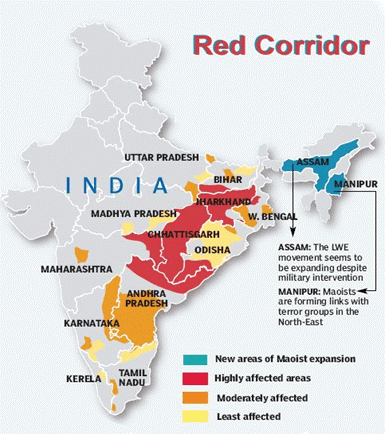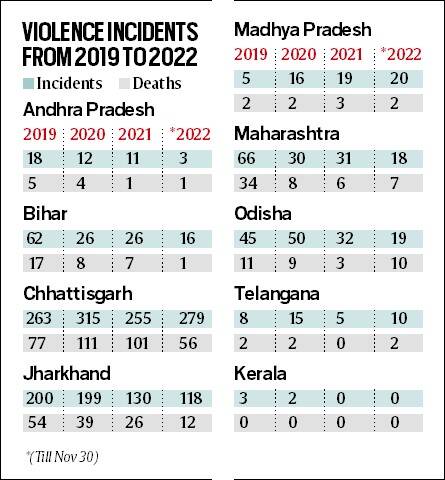
Copyright infringement is not intended
Context:
While incidents of violence from Left-Wing Extremism (LWE) in the country have dropped by 77 per cent between 2009 and 2021, state-wise data showed an increase in such incidents in Chhattisgarh, Madhya Pradesh and Telangana this year in comparison to the previous year, and a decrease in incidents in Maharashtra, Odisha, Jharkhand and Bihar among others, according to data provided by the Ministry of Home Affairs in Rajya Sabha.
.jpg)
Details:
- The data also showed a decline in the number of deaths from LWE violence in Chhattisgarh and Jharkhand as well as other states.
- Data of LWE violence in Chhattisgarh, Jharkhand, Bihar, Madhya Pradesh, Andhra Pradesh, Maharashtra, Odisha, Telangana and Kerala showed that 670 incidents took place in 2019, 665 in 2020, 509 in 2021 and 483 this year (until November 30).

- Deaths of civilians and security forces have reduced by 85 per cent from a high of 1,005 in 2010 to 147 in 2021.
- While Jharkhand saw 118 incidents and 12 deaths this year, there were 130 incidents and 26 deaths in 2021, 199 incidents and 39 deaths in 2020, and 200 incidents and 54 deaths in 2019.
- To address LWE holistically, the central government approved a national policy and action plan in 2015. This policy envisages a multi-pronged strategy involving security related measures, development interventions, ensuring rights and entitlements of local communities, etc. Steadfast implementation of this policy has resulted in consistent decline in violence in LWE affected areas.
Steps undertaken:
- The Government has adopted a holistic approach to deal with Left Wing Extremism, in the areas of security, development, ensuring rights and entitlements of local communities, improvement in governance and public perception management.
- Though primarily a State subject, Ministry of Home Affairs (MHA) has promulgated a ‘National Policy and Action Plan’ since 2015 to address the Left Wing Extremism (LWE) menace holistically and the progress & the situation is being monitored rigorously and this Policy consists a multi-pronged approach.
- Review and monitoring mechanisms:These include intelligence sharing through Multi-Agency Centre (MAC) at the Central and State levels, and Multi Agency Centre (SMAC) at the subsidiary level on a 24x7 basis.
- Better inter-state coordination:Government of India has taken a number of steps to improve inter-state coordination which includes frequent meetings and interactions between the official machinery of the bordering districts of Left Wing Extremism affected States across the country.
- Tackling the challenge of Improvised Explosive Devices (IEDs):The Union Home Ministry has formulated a Standard Operating Procedure (SOP) on ‘Issues related to Explosives/IEDs/Landmines in naxal affected areas’ and the same has been circulated to the stakeholders for compliance.
- Strengthening of air support:State Governments and the Central Armed Police Forces (CAPFs) have been provided with enhanced air support in terms of UAVs and helicopters for anti-naxal operations, including evacuation of causalities/injured persons.
- Security Related Measures
- Deployment of the CAPFs:Battalions of the CAPFs/Naga Battalions (BNs) are deployed for assisting the State Police in the LWE affected States.
- India Reserve (IR)/Specialised India Reserve Battalion (SIRB):Naxal affected States have been sanctioned 45 IR battalions mainly to strengthen their security apparatus and also to enable the States to provide gainful employment to youth, particularly in the severely affected belts.
- Security Related Expenditure (SRE) Scheme:funds are provided for meeting the recurring expenditure relating to insurance, training and operational needs of the security forces, rehabilitation of Left Wing Extremist cadres who surrender, community policing, security related infrastructure for village defence committees and publicity material to create awareness against violence.
- Construction/Strengthening of Fortified Police Stations
- Scheme for Special Infrastructure (SSI):This Scheme was started during the 11th Plan period with 100% funding by the Centre for filling up critical infrastructure gaps, not be covered under any other scheme.
Ministry of Home Affairs is supporting the State Governments for Capacity Building and strengthening of Security Apparatus by:
- deployment of CAPF Battalions,
- provision of helicopters and UAVs and
- sanction of India Reserve Battalions (IRBs)/ Special India Reserve Battalions (SIRBs).
- Funds are also provided under Modernization of Police Force (MPF), Security Related Expenditure (SRE) Scheme and Special Infrastructure Scheme (SIS) for modernization and training of State Police.
For development of LWE Affected States, Government of India (GoI) has taken several developmental initiatives which include:
- sanction of 17,600 Kilometers of road under Road Requirement Plan-I.
- to improve telecom connectivity in LWE affected districts, Mobile Towershave been installed
- for financial inclusion of the people in LWE affected districts, Post Offices, Bank Branches, ATMs and Banking Correspondents have been opened
- for imparting quality education to the youth in areas affected by LWE, special focus is given to opening of Eklavya Model Residential Schools (EMRS).
- under Special Central Assistance (SCA) Schemefor further impetus to development in the most affected districts, more than 10000 projects have been taken of which more than 80% are already completed.
- Integrated Action Plan (IAP)/ Additional Central Assistance (ACA): commenced in 2010-11 covering 60 Tribal and Backward districts for accelerated development by providing public infrastructure and services
- Implementation of Scheduled Tribes and other Traditional Forest Dwellers (Recognition of Rights) Act, 2006
- Civic Action Programme (CAP): This Scheme is under implementation from 2010-11.
- Surrender and Rehabilitation Policy
MHA had categorized certain districts as LWE affected and covered under Security Related Expenditure (SRE) Scheme for specific resource mobilization to the affected States for counter LWE measure.
- Of these SRE districts, the districts accounting for more than 85% of country-wide LWE violence and are categorized as ‘Most Affected Districts’ for focused deployment of resources - both security and development related.
- To arrest the expansion plan CPI (Maoist) and also to restrict them to bounce back in the areas recently taken away from LWE influence, 08 districts have been categorized as ‘District of Concern’. The revised categorization is a more realistic representation of current LWE scenario.
- Greyhounds: It was raised in 1989 as an elite anti-Naxal force.
- Operation Green Hunt: It was started in 2009-10 and massive deployment of security forces was done in the Naxal-affected areas
- Aspirational Districts Programme: Launched in 2018, it aims to rapidly transform the districts that have shown relatively lesser progress in key social areas.
- SAMADHAN doctrine is the one-stop solution for the LWE problem. It encompasses the entire strategy of government from short-term policy to long-term policy formulated at different levels. SAMADHAN stands for-
- S- Smart Leadership,
- A- Aggressive Strategy,
- M- Motivation and Training,
- A- Actionable Intelligence,
- D- Dashboard Based KPIs (Key Performance Indicators) and KRAs (Key Result Areas),
- H- Harnessing Technology,
- A- Action plan for each Theatre,
- N- No access to Financing.
- ROSHNI is a special initiativeunder, Pandit Deen Dayal Upadhyaya Grameen Kaushalya Yojana (Formerly Ajeevika Skills), launched in June 2013 for training and placement of rural poor youth from 27 LWE affected districts in 09 States
- Intelligence sharing and raising of a separate 66 Indian Reserved Battalion(IRBs), CRPF battalions like COBRA battalion, Bastariya battalion etc were done by the government to curb the menace of LWE organizations.

Background:
- A number of Left Wing Extremist outfits have been operating in certain remote and poorly connected pockets of the country for a few decades now.
- Maoist motto, "power flows from the barrel of gun", is their motivating force.
- Naxalites seek to overthrow the State through violent means.
- They openly proclaim lack of faith in the democratic means of ballot and adhere to the violence as a means of achieving their ends.
- Naxal affected areas in India are known as the 'Red Corridor'.
- The Naxal movement started with the tribal-peasant uprising against landlords in Naxalbari village of Darjiling district, West Bengal in 1967.
- Later, this militant movement spread all over West Bengal and was carried on by a large number of other groups in different States.
- Naxals are also known for their liaison with external terrorist outfits like LTTE for pooling of resources, particularly in the acquisition of weaponry, communication technology and the like.
- Violence being the driving force of Naxal ideology, they often resort to killing and kidnap.
- The Maoist insurgency doctrine glorifies violence as the primary means to overthrow the existing socio-economic and political structures.
Causes of left-wing extremism in India:
- The failure of land reforms especially land redistribution after independence.
- Socio-economic inequities, unemployment, despair about the future.
- Dishonest and self-serving dominant groups
- Political deprivationleading to hopelessness or a sense of powerlessness.
- Lack of title to public land cultivated by the landless poor.
- Governance deficit in the remote parts of Red Corridor regions.
- Lack of food security– corruption in the Public Distribution System (which are often non-functional).
- Disruption of traditional occupations and lack of alternative work opportunities.
- Displacement of people:Eviction from lands traditionally used by tribals.
Issues Related to Dealing With LWE:
- In the current scenario, barring a few exceptions, many of the senior police officers (IPS cadre) who are parachuted into the central police forces at senior ranks have little or no platoon/battalion experience.
- It is not ideology and revolutionary zeal that is driving people who are engaged in LWE. For many, joining these groups is the only way to survive.
- Threatening Democracy.
Way Forward:
- Innovative measures are required to be employed in preventing IED(Improvised Explosive Device) related incidents which have caused significant casualties in recent years.
- Emphasis should be laid on the capacity-building and modernization of the local police forces.
- States should rationalize their surrender policy in order to bring innocent individuals caught in the trap of LWE in the mainstream.
- States also need to adopt a focused time-bound approach to completely eliminate LWE groups and ensure all-round development of the affected regions.
- What makes the LWE particularly disturbing is its correlation with the demographic youth bulge in the general Indian population. If the Indian state fails, the widespread unemployment could lead to a serious internal security situation. LWE is its first manifestation.
- The adverse casualty ratio in police-Naxal operations highlights the fact that insurgencies are best tackled by military forces that are trained and structured for this role
- The Centre and the States should make efforts in sync that are crucial in eliminating such radicalization amongst groups (like confidence-building measures, education, welfare schemes etc)
https://indianexpress.com/article/india/maoist-violence-deaths-down-chhattisgarh-sees-rise-in-cases-8341426/





